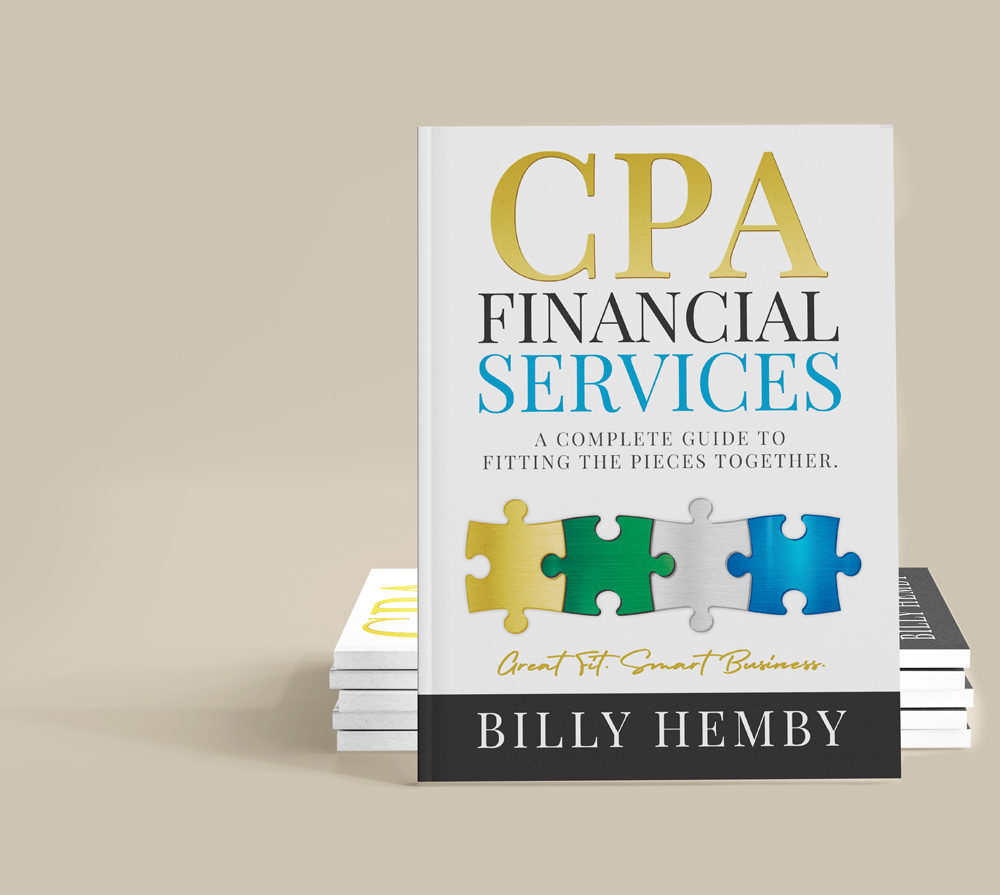
CPA Financial Services
A complete guide to fitting the pieces together
One of the most potentially profitable and rewarding business pursuits established within a CPA firm is financial services. Financial advice is a complimentary service to add to the traditional disciplines of tax preparation, accounting, audit work, bookkeeping, and payroll services. Even more contemporary lines of services, such as business advisory consulting, certified valuations, analytics, and assurance work, would not offer the same leverage of time and resources with recurring revenues in the way provided through financial services.

Clients sometimes view CPAs simply as compliance, tax, audit, or assurance professionals. Offering additional financial services can transform CPAs into becoming a trusted advisor, partner and guide.

About the Author
Billy Hemby is a Managing Director with Level Four located in the Carr, Riggs & Ingram, LLC (CRI) offices in North Carolina. He is active as a wealth advisor as well as the ensemble team leader for the region. Prior to joining Level Four he was a founding partner of PPC Financial Group, a wealth management division of Pittard Perry & Crone, CPAs and Advisors before their merger with CRI. With over 30 years of experience in the business, he is passionate about bringing financial advice into the CPA field.

Select A Topic to Learn More
Your Title Goes Here
Your content goes here. Edit or remove this text inline or in the module Content settings. You can also style every aspect of this content in the module Design settings and even apply custom CSS to this text in the module Advanced settings.
Deciding to Offer Financial Services through a CPA Firm
1.Only pursue CPA financial services if you really believe in the mission.
a. Put your heart into it.
b. Speak with conviction.
c. Enjoy the experience.
2. It is essential to believe that you are providing to clients a valuable service that is integrated and well-delivered.
a. Take pride in your work.
b. Make a quality product.
c. Put a ‘bow on it.’
3. It may be most efficient for CPAs and Financial Professionals to partner together so that complementary services and proficiency can be established at an optimal level.
a. Be a team player.
b. Specialize.
c. Make referrals to other specialists.
4.Time management can be successfully leveraged to allow for top level work to be done within the different disciplines.
a. Do what you do best.
b. Delegate the rest.
c. Value your time.
5. CPAs can establish a significant business revenue stream by establishing financial services as part of their practice.
a. Traditional accounting work is limited to time and energy.
b. Partner with a Financial Professional.
c. Financial services revenue is recurring and not limited to time and energy.
6.It’s a passive way to boost profits without a significant allocation of time.
a. Increase value for you practice.
b. Delegate financial services work to a team of specialists.
c. Break the time for dollars model.
Finding the Right Fit for the CPA Firm and the Financial Professional
1.The single most important component to a successful partnership is shared culture.
a. Find a natural attraction.
b. Find someone you like.
c. Make it a true partnership.
2.There should be similar values and style between the CPA and the Financial Professional.
a. Believe similarly.
b. Act similarly.
c. Advance similarly.
3. Birds of a feather flock together. You should enjoy working with the people with whom you co-labor.
a. Be glad to see them.
b. It should not feel like work.
c. Work together.
4.Pick a business partner that you like and create a great experience.
a. Be selective.
b. Be happy.
c. Make it a good ride.
Developing a Proposed Business Plan for Financial Services
1.Have a written business plan to outline the intended path forward for business development.
a. Organize a battle plan.
b. Write down the strategy to make it real.
c. Communicate the plan.
2.When contending for a strategic business partnership, this can be a differentiating factor.
a. Show up to win.
b. Look and be professional.
c. Mean business.
3.The business model should be fluid to allow for changes based on business development as it occurs.
a. Have a working outline.
b. Be flexible.
c. Develop with the business.
4.Don’t base the business plan on unrealistic goals and objectives that can’t be accurately perceived in advance.
a. Dial it in clearly.
b. Underestimate at first.
c. Don’t over extend.
5.Staffing should be modest at first.
a. Hire a versatile manager.
b. Under-do it at first.
c. Save costs until more is justified.
6.Start small and grow from there.
a. One assistant.
b. Two assistants.
c. Associate Financial Professional.
Developing the Best Structure for Business
1. A formal partnership cements the business relationship between the CPA and the Financial Professional.
a. Treat it like a real business.
b. Participate jointly.
c. Make it mutually beneficial.
2.The business entity structure provides a platform upon which to do business.
a. The business format identifies structure.
b. The entity formalizes the partnership.
c. Long-term business development can be sustained.
3.The firm would choose how each participant is to be paid.
a. Clear compensation is important.
b. Don’t favor one over another.
c. Make sure payday is a good experience.
4.When the entity is smaller with fewer partners, licensing for each person can be considered. If the entity is larger with more partners, profit recognition could be done at the entity level based on percentages of ownership and the type of business that is done.
a. Decide on licensing for partners.
b. Make sure there is motivation for work and referrals.
c. Provide clear tracking for production credit.
Creating and Managing a Business Development System
1.The most essential component for success is personal involvement by CPAs and Financial Professionals in communicating with clients about financial services that are available.
a. Be involved in heart and deed.
b. Tell the story.
c. Create opportunities.
2.A strong belief level must be perceived by clients to promote business.
a. Believe in the story.
b. Build client belief.
c. Always be promoting.
3.Clients need to see the Financial Professional as a true partner of the CPA.
a. It’s about the client.
b. Sell the Financial Professional.
c. Be real partners.
4.There must be clear collaboration within the partnership.
a. Do your partner good.
b. Work together in spirit.
c. Work together indeed.
Establishing and Maintaining a Client Management System
1. A client management system that is easy to use and that provides adequate data storage and client contact management is important.
a. Have a system.
b. Make the system easy to use.
c. Provide quick access.
2. All financial services team members must be integrated into a centralized system of client support and communication to sustain a level of excellence in client services and new business generation.
a. Include the whole team.
b. Coordinate efforts.
c. Excel.
3.Fully utilize the client management system.
a. Segment clients.
b. Contact clients.
c. Keep good records for clients.
Pursuing Specialized Disciplines of Financial Services
1.In the beginning start small with a few core competencies in developing financial services business.
a. Be a generalist at first.
b. Repetition is the key.
c. Master a discipline.
Build on that with additional specialists to allow greater expertise in business development.
a. Divide.
b. Multiply.
c. Advance.
2. As business and revenue builds, continue to invest in more support personnel and specialists whose focus promotes higher levels of excellence and proficiency in the various disciplines of financial services.
a. Save up.
b. Find more good people.
c. Develop good people.
Financial Planning: To Fee or Not to Fee
1. Fee-for-service work provides a business niche that can set a firm apart from its peers and rivals.
a. Decide to differentiate.
b. Find out how to do it.
c. Do it.
2.This discipline allows for an objective approach that can provide a range of services that are more advanced and that may appeal to higher profile clients.
a. Write a prescription.
b. Cover many topics.
c. Appeal to your top clients.
3. Financial planning complements the style of business established by the CPA firm and can lead to additional business in the other disciplines of financial services including investment asset management, insurance risk management, and employer benefit plan management.
a. Mirror financial planning and accounting engagement styles.
b. Uncover new opportunities.
c. Integrate disciplines.
3 Most Important Keys: Communication, Communication, Communication
1. CPAs and Financial Professionals must consistently communicate with each other through a variety of media to be sure to work well together on behalf of clients.
a. Spend time together.
b. Talk with each other.
c. Sustain communication.
2. This builds good will and good rapport.
a. Trust each other.
b. Rely on each other.
c. Enjoy working with each other.
3. Financial professionals must communicate well with all team members to make sure that there is a good flow of operations within the financial services group.
a. Associate Financial Professionals must communicate with each other.
b. Be inclusive.
c. Flow smoothly.
4.Formal and informal communication must be sustained by CPAs and Financial Professionals with clients to uncover new business opportunities and retain existing client accounts.
a. Communicate naturally.
b. Speak up.
c. Focus on clients.
Managing Seasons of Change
1.Prepare for the unexpected. Think through changes that could happen over the course of time to establish contingency plans that can work.
a. Be alert.
b. Peer around corners.
c. Rehearse ‘fire drills.’
2. Discuss difficult topics pertaining to business continuity. This enhances participation and agreement among partners and builds trust. Anticipation of potential business disruption equips participants for readiness when changes occur.
a. Embrace tough topics.
b. Look to find common ground.
c. Be ready.
3.Change is constant. Understand that changes will occur.
a. Savor the past.
b. Prepare for the future.
c. Change.
Cultivating a Successful Business Continuation Plan and Exit Strategy
1.It is important to plan for a culmination of the business model. The business entity may continue but participants may transition. Identify best possible outcomes as business development occurs.
a. No cycle lasts forever.
b. The business can continue but the players can’t.
c. Make the hand-off smoothly.
2. Identify potential candidates for business continuation. Communicate observations and expectations about development of a business succession plan. Cultivate ‘buy-in’ by potential successors along the way so that agreement is established when transitions occur.
a. Find good talent.
b. Work for agreement.
c. Be on the same side.
Understanding the Cycles of the CPA Firm Financial Services Business
1. If a financial services group is successful, there will be natural seasons of progression.
a. Get used to winning.
b. Keep winning.
c. Move forward.
2. Make a plan that identifies the cycles of the business so that when seasons change, resources are available to maintain a strong business model.
a. Function in the present.
b. Prepare for the next season.
c. Set aside resources for the future.
3. Embrace each season as it comes. Each change of season is necessary and is part of a healthy progression when it is recognized and properly navigated by each participant.
a. Move smoothly through different periods of time.
b. Understand and appreciate each season.
c. Manage each stage of development.
What Industry Professionals Are Saying
